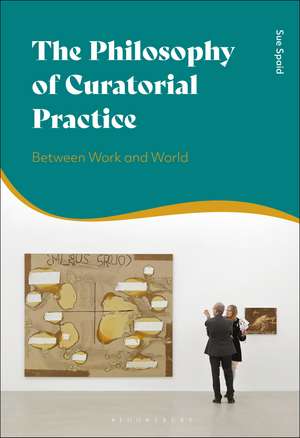The Philosophy of Curatorial Practice: Between Work and World
Autor Sue Spaiden Limba Engleză Hardback – 14 oct 2020
| Toate formatele și edițiile | Preț | Express |
|---|---|---|
| Paperback (1) | 199.28 lei 6-8 săpt. | |
| Bloomsbury Publishing – 20 apr 2022 | 199.28 lei 6-8 săpt. | |
| Hardback (1) | 599.57 lei 6-8 săpt. | |
| Bloomsbury Publishing – 14 oct 2020 | 599.57 lei 6-8 săpt. |
Preț: 599.57 lei
Preț vechi: 859.25 lei
-30% Nou
Puncte Express: 899
Preț estimativ în valută:
114.83€ • 118.31$ • 96.19£
114.83€ • 118.31$ • 96.19£
Carte tipărită la comandă
Livrare economică 24 februarie-10 martie
Preluare comenzi: 021 569.72.76
Specificații
ISBN-13: 9781350114890
ISBN-10: 1350114898
Pagini: 280
Ilustrații: 19 bw illus
Dimensiuni: 156 x 234 x 25 mm
Greutate: 0.59 kg
Editura: Bloomsbury Publishing
Colecția Bloomsbury Academic
Locul publicării:London, United Kingdom
ISBN-10: 1350114898
Pagini: 280
Ilustrații: 19 bw illus
Dimensiuni: 156 x 234 x 25 mm
Greutate: 0.59 kg
Editura: Bloomsbury Publishing
Colecția Bloomsbury Academic
Locul publicării:London, United Kingdom
Caracteristici
Draws on a range of examples including Netherlandish painting, Impressionism, Dada, Surrealism, Cubism, and Arte Povera, as well as more contemporary exhibitions such as "When Attitudes Became Form" (1969), "Picasso: Guitars 1912-1913"(2011), Maurizio Cattelan's "All" (2011), and "Damien Hirst" (2012)
Notă biografică
Sue Spaid is an Independent Scholar and Associate Editor of Aesthetic Investigations.
Cuprins
AcknowledgementsList of Figures1. Introduction2. The Curators3. Spectators4. Exhibitions5. Nonexhibited Features6. The Impact of Exhibitions on Aesthetics7. Cycles 8. The UbercuratorBibliographyIndex
Recenzii
A necessary addition to the literature on curating, Sue Spaid's book scopes a philosophical shape for an understanding of curating. It places a stake in the tradition of aesthetics for exhibitions, as distinct from artworks and artist's intentions. Spaid underpins this philosophy nonetheless with her considerable knowledge and experience as a museum curator. In the growing literature on curatorial theory and the history of exhibitions, there isn't any other book quite like The Philosophy of Curating. It is an original and invaluable book.
As a practitioner, Spaid creatively reveals the inner workings of the collaborative Artworld to (finally) give voice to the curator. Her fresh and provocative vision - challenging the aesthetics of Beardsley, Danto and Dickie - is rich with examples of exhibitions-as-events that pose hypotheses to spectators who play a vital interpretive role.
The Philosophy of Curatorial Practice provides an invigorating new model for articulating the practice of curating today. It argues, from the unprecedented premise of analytical aesthetics, that exhibitions tether artworks to the world in order to enable audiences to access their meaning. This is without doubt a most welcome addition to the nascent field that is the philosophy of curating.
What a book! Sue Spaid is an exception among contemporary art curators. Rather than rely on critical theory, she works rigorously within a framework of analytical and continental philosophy. She tempers her analyses with first-hand knowledge of the tough realities of the artworld, often missing from theoretical discussions. A triumph!
The Philosophy of Curatorial Practice is an important addition to curatorial studies. Working beyond art history, it positions curating as a form of engaged practice. Astutely taking on philosophical theory, it moves behind the scenes of display, to reveal those often obscured strategies which lend meaning to the work of art.
[This book] charts helpful vectors of interest for future scholarship. On a personal note, as someone who has had the opportunity to debate Spaid on the subject of curating, both at live events and in print, I consider her book a meaningful addition to the conversational momentum the topic has been enjoying.
As a practitioner, Spaid creatively reveals the inner workings of the collaborative Artworld to (finally) give voice to the curator. Her fresh and provocative vision - challenging the aesthetics of Beardsley, Danto and Dickie - is rich with examples of exhibitions-as-events that pose hypotheses to spectators who play a vital interpretive role.
The Philosophy of Curatorial Practice provides an invigorating new model for articulating the practice of curating today. It argues, from the unprecedented premise of analytical aesthetics, that exhibitions tether artworks to the world in order to enable audiences to access their meaning. This is without doubt a most welcome addition to the nascent field that is the philosophy of curating.
What a book! Sue Spaid is an exception among contemporary art curators. Rather than rely on critical theory, she works rigorously within a framework of analytical and continental philosophy. She tempers her analyses with first-hand knowledge of the tough realities of the artworld, often missing from theoretical discussions. A triumph!
The Philosophy of Curatorial Practice is an important addition to curatorial studies. Working beyond art history, it positions curating as a form of engaged practice. Astutely taking on philosophical theory, it moves behind the scenes of display, to reveal those often obscured strategies which lend meaning to the work of art.
[This book] charts helpful vectors of interest for future scholarship. On a personal note, as someone who has had the opportunity to debate Spaid on the subject of curating, both at live events and in print, I consider her book a meaningful addition to the conversational momentum the topic has been enjoying.
